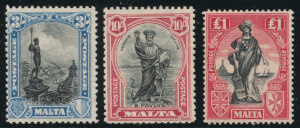Collectors either esteem or denigrate the earlier stamps of British Commonwealth and they do so for the same reason. From about 1890 to the QE II period (1953), the stamps of nearly all the Commonwealth colonies are the same-small stamps with a portrait of the reigning monarch (either Victoria, Edward, George V or George VI)-distinguished by stamp collectors by scores of varieties by monarch, denomination and watermark. Many find it very redundant. Others exhilarate in the variety on a simple theme. Some like Mahler. Some like Bach. But several of the British Commonwealth colonies in the 1920s and 1930s experimented with change and collectors have rewarded these experiments with great collecting popularity. These countries (and Malta and Jamaica come to mind immediately) withdrew from the Crown Agents printing and design group and began to plan their own stamps with themes that were germane to the politics and history of the particular Colony. These stamps and countries are even more popular than ordinary British Commonwealth stamps because of this. As British Colonials, collectors need these stamps the same as they need their British Honduras for completion. But the interest of design has also attracted many collectors to the philately of countries like Malta who ordinarily would have avoided British Commonwealth collecting. These are stamps for collectors who like both Mahler and Bach.
Colonial Differences
Archive

